Kava Drinking in Vanuatu
Part One of a Three-Part Series Focusing on the South Pacific
The newsroom was especially dark on this morning. Not surprising, it was 4AM. With my Hawaiian shirt smelling of a combination of week-old tuna and whiskey and not having been in contact with an iron in over 10 days, I entered my office and dropped my bag and hat on my chair. But such aesthetic things would have to be taken care of in do time, I thought as I pushed my mail onto the floor and decided a few winks were in order...
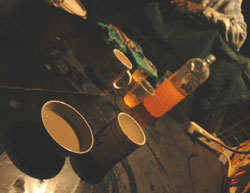 Seemingly just as I had shut my eyes, a burst of flame came hurtling overhead and flooded the room. With caution I fully raised my lids and found junior reporter Junko standing next to my window with the blinds now open and sunlight pouring in from behind her.
Seemingly just as I had shut my eyes, a burst of flame came hurtling overhead and flooded the room. With caution I fully raised my lids and found junior reporter Junko standing next to my window with the blinds now open and sunlight pouring in from behind her.
"Jeez, don't they have laws in this country against doing that at this hour?" I asked in shielding my eyes.
"It's nine in the morning," she said standing with her arms crossed. I slowly peered up but could only see her silhouette. I knew however, from the tone of her voice that the look on her face was similar to the time she found out that I was trying to buy lucrative rice contracts from African heads of state for suitcases of $80,000 cash.
"Didn't see you come in," I said. "Just trying to get my land legs back." I gingerly moved onto my office chair and pulled my pack of smokes from my shirt pocket.
"By sleeping on your desk? Hit a hostess club between the airport and here?"
"Well, as you know, if there's business to be taken care of, I am not one put things off until the next day. But I also took care of business in the South Pacific," I reassured. I put my feet on the desk and lit a smoke. "Don't you worry none about that."
Trader Vic's in Port Vila, Vanuatu was where it started. Sergio, a Frenchman, is the owner.
Outside in the garden area, I played with my burning cigarette at one of the tables that overlooks the harbor. The sun was going down and sea urchins were stirring on the bay's bottom. The palms swayed with the strong onshore breeze beneath the cloud-darkened sky. My driver, a Ni-Vanuatu, was seated next to me.
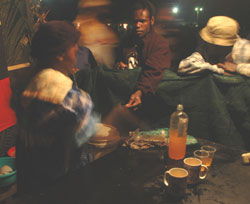 I dropped what was left of my smoke into an ashtray and went up to the bar and got us our first round of drinks. At the counter were an assortment of snacks; meat and vegetable pies, stick meat (grilled onions and beef on wood skewers), and laplap (island cabbage wrapped around tapioca with coconut milk). I ordered up two shells of kava of the 100-size variety, a meat pie, and a laplap.
I dropped what was left of my smoke into an ashtray and went up to the bar and got us our first round of drinks. At the counter were an assortment of snacks; meat and vegetable pies, stick meat (grilled onions and beef on wood skewers), and laplap (island cabbage wrapped around tapioca with coconut milk). I ordered up two shells of kava of the 100-size variety, a meat pie, and a laplap.
"Sometimes if you have weak bones or are overweight, it is recommended by doctors in Vanuatu that you drink kava as a means of help," my driver told me as I returned to the bench with the drinks and vittles. He immediately drank his in one swallow and set the red and white bowl on the table.
Kava is a root-based drink famous in Vanuatu and the South Pacific. The drink is a drug whose effects are said to vary from an enhanced state of relaxation to the curing of cancer. It would seem the belief in the latter medicinal properties is not limited to the medical men of Vanuatu however as New Caledonia, Australia, and the U.S. now import Panadol, a powdered form of kava, across their borders.
During traditional preparation, the kava root is ground in a meat grinder and the resultant powder mixed with water in a large pot. It is ladled out into half coconut-shaped plastic shells that range in size from 50 to 200 with the number representing the cost in vatu (140 vatu is approximately $1).
I took my driver's lead and tipped the shell back, allowing the murky but thin brown liquid to go down in one gulp. Tasty kava is not. The best I can offer is that it is sort of like drinking dirt and water, at least it is how I imagine a mixture of dirt and water might taste. My driver then started spitting onto the grass around the bench. In fact, other customers in the garden were also spitting. This is presumably because the sensation afterwards, and not the taste, is that desired by the drinker.
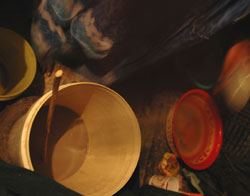 As I started on my laplap, my driver stressed the art of drinking kava, "After the first cup, you must listen to the kava, stay cool, and, uh...what should I say, meditate. You will then feel the effect coming. You can then relax, feel no stress, and lose all focus."
As I started on my laplap, my driver stressed the art of drinking kava, "After the first cup, you must listen to the kava, stay cool, and, uh...what should I say, meditate. You will then feel the effect coming. You can then relax, feel no stress, and lose all focus."
It is a numbing effect; first the tongue, then the entire mouth. After a few minutes, a dulled sensation slowly sweeps over your entire body in waves, even slowing the chewing process of eating tapioca.
"Some people don't like noise when drinking. They don't want the kava to be disturbed. Many people don't even want stories. If there are stories, they cannot understand the kava," he added.
He bit into his meat pie and explained that there are of course some hazards to this means of relief. "For a typical person, it takes 5 or 6 shells of the 100-size before one becomes incapable of conversation. If one is addicted, it could take anywhere from 12 to 15."
In looking around at the other customers, I could see the effects certainly weren't the same for everybody. Some folks at a large table nearby were content to smoke cigarettes after downing a shell. Others leaned back in their seats, looking almost comatose, in an attempt to perhaps understand what the kava was saying. Still others snarled like cats in a playful manner with one another. Like the effects of kava on people, the means of drinking is not a constant either.
"We call these shells," he said in holding up his plastic bowl.
"That is because before we used real half coconut shells. But cleaning a coconut shell was not easy and the spread of Hepatitis became a problem. Also we used to use special rocks to grind the kava. But a meat grinder is much easier nowadays," he explained by pointing over at the large piles of ground kava root spoil near the water's edge.
I stood up and in a swirl of light-headedness went up to the bar and got us two more shells and two skewers of stick meat. We both downed ours together. He again began the spitting ritual.
In between the gusts of wind, I could hear a pulsing reggae beat in the distance. I gently picked the onions and meat off my skewer.
"So what's that music?" I asked.
"Oh that is from the Festnapuan. It is an annual two-day event of music taking place at the Port Vila Cultural Center. The bands are from New Caledonia, Solomon Islands, Fiji, and Vanuatu. Tonight is the first night. You wanna go?"
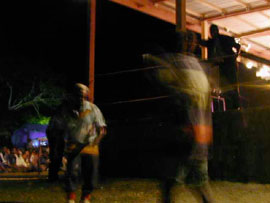 With the kava still moving through me and the sun now beneath the horizon, I fumbled through my pocket for my pack and lit a cigarette.
With the kava still moving through me and the sun now beneath the horizon, I fumbled through my pocket for my pack and lit a cigarette.
The crowd was of all ages and extended throughout the entire lawn fronting the Cultural Center. Vendors sold a variety of food and some clothing. But the focus was on the music, and sometimes peace in the South Pacific.
"The war is over! Peace and normalcy to the Solomon Islands!" exclaimed the singer from the band Arm Rock Solid. The mostly seated crowd numbering around 20,000 roared its approval at this claim of a stop in the recent fighting in the band's home country. Red, yellow, and white lights flickered behind the band as they started their version of Bob Marley's "Stir it Up."
Near the stage, a young boy decided to start dancing. The crowd applauded his bold move. Soon though he was not alone. A gray haired and bearded man with bright red socks in his 60s got up and did a slow disjointed type of dance that emphasized slow motions with his hands and feet. The crowd laughed, hooted, and screamed. Sensing his fleeting fame, the youth, with cigarette dangling from his lip, tried to top him by frantically flailing wildly in groove to the rhythm of the drums and bass. He was still no match to the old man's slow hands and steps in garnering the crowd's attention. The kava was losing mine as well. It was starting to fade.
My driver explained to me that when the waning begins, it is sometimes good to eat something. We moved on down to the 24-hour Central Market.
After thoroughly describing the colors and variety of the coconuts, taro, tapioca, papayas, and yams, available at the market, I explained to Junko in detail about the tuluk (traditional Vanuatu food consisting of tapioca with shredded pork inside) that I bought from a vendor.
"So how did it taste?" she asked.
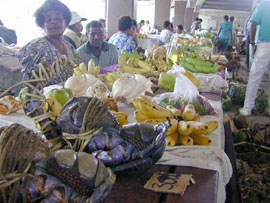 "A little greasy and heavy on the stomach but certainly very good," I said. She started for the door thinking the story was over.
"A little greasy and heavy on the stomach but certainly very good," I said. She started for the door thinking the story was over.
"Oh, but also the market had live coconut crabs. It is a huge blue alien-looking thing," I said. "Its head alone is about the size of this here cup." I grabbed my coffee cup off my desk and held it out upside down. She paused at the door.
I blew any accumulated dust from its inside to emphasize that it was empty and continued, "The crab's shell is deep blue and it apparently can tear coconuts open with its claws, hence the name. Actually, I ate coconut crabs a Chinese restaurant earlier in the week when I visited Santo Island."
"Ok, let's hear the story about Santo," she said in returning back inside.
"How about a little petrol first?" I pushed my cup to the edge of the desk near to where she was standing.
Sometimes I can smell a woman's perfume from the draft she creates as she walks past. But, as I found out that morning, a surprisingly similar effect is achieved if she flips her hair quickly in abruptly leaving a room. In any case, my story about Santo, and my coffee, would have to wait until later.
Coming next week: Vanuatu's Santo Island

